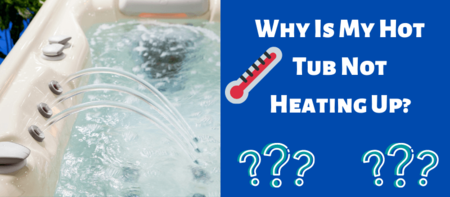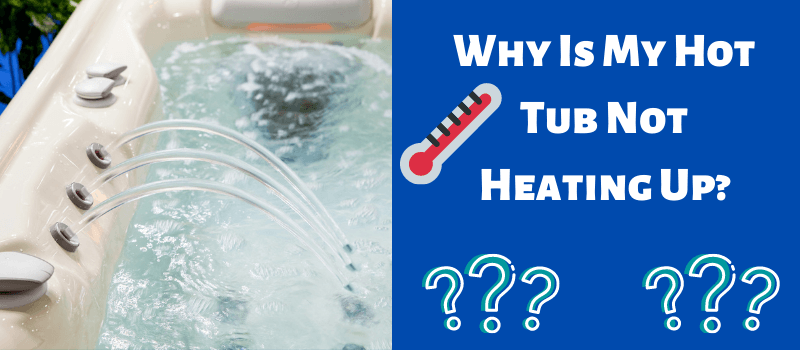
Have you ever experienced the major disappointment of jumping into your hot tub only to discover that it wasn’t hot? If your hot tub isn’t heating up then you will want to find out the cause of the problem as quickly as possible. I decided to do some research and this is what I found out.
So, why is my hot tub not heating up? There could be many reasons for a hot tub not heating up. These range from a low flow issue to a faulty thermostat, and they could include a damaged heater element or a faulty high limit switch. The key is to find the cause of the issue so that it can be quickly rectified.
Luckily, there are plenty of things you can do to determine the source of the problem. Here, we’ll take a closer look at the various options that you can consider and what to do when you pinpoint the cause.
How Can I Tell If The Hot Tub Heater Isn’t Working?
When your hot tub heater doesn’t heat your tub up properly, you’ll find that the water fails to reach the optimal temperature. This could happen for many reasons. These include:
- A problem with the high limit switch – this safety feature is designed to prevent the heater from melting down or overheating, but if it’s broken it could result in a hot tub heater problem.
- A low water flow – often, this is due to a dirty and clogged water filter or clogged pumps, blocked drains or closed valves.
- Thermostat issues – when the thermostat has a knob it’s possible to test for breakage or damage inside or corrosion around the sensor bulb. If there is a red arrow on the thermostat, you’ll have to check for damage on the cord and ensure you’ve properly plugged it in. You’ll also need to examine the control unit.
- A cover problem – if the cover of your hot tub is torn, damaged, sagging or waterlogged it’ll need replacing. When a tub is poorly covered, the heat can escape and this makes the tub fail to heat up properly.
- A wiring problem – sometimes rodents may chew the hot tub wires and this can cause the equipment to malfunction so the water no longer heats. If the wires melt, this could also result in heater issues. It’s therefore important to regularly inspect the wiring that comes into and out of the tub’s control panel to check for any sign of damage.
- A weather issue – if you turn the hot tub off during the winter but fail to winterize it properly, the hot tub may freeze up which may cause damage to the equipment resulting in a problem with the water heater.

Since any of these issues could be at fault, it’s important to pinpoint the precise cause of the problem so that it can be quickly rectified. If you don’t, you won’t be able to resolve the issue and you’ll be unable to enjoy a warm and relaxing soak.
Could Low Water Flow Be Causing My Problem?
If your hot tub has low water flow, this could be due to a dirty or clogged spa filter. When the spa heater doesn’t heat up the water properly, you should remove the filter and clean it thoroughly. This will rule out a problem with the flow rate or the water pressure.
You can find out how to clean your filters in my post here and if you need a replacement filter Amazon have a good selection on this page.
If the water level is low, the valves are closed, or the pipes, pump impeller or spa drain covers are blocked, this could also result in flow issues. Sometimes, hot tub heaters will have a screen on their inlet side for trapping the debris that accidentally manages to pass the filter. Should this screen get clogged up, the water flow that is able to enter the spa will be reduced.
Since a spa heater requires enough water flow to function properly, when there is insufficient flow, the heater will switch itself off. There will be a pressure switch inside the heater chamber which will sense if the flow of water is too low to protect the water heater properly.
The pressure switch breaks the electric circuit that powers the heater element, shutting the heater down if the flow isn’t sufficient. Once you establish a proper water flow once more, the heater will begin to function again.
You can test most types of pressure switch by using jumper wires to connect both wires together to bypass the switch. A lot of hot tub pressure switches are adjustable using a slotted screw or thumb wheel to shut the circuit when it reaches a specific pressure rating. As an example, some can be adjusted between 1 and 5 PSI. If you turn the screw or wheel, you can make minor adjustments to the switch, however, choosing the setting that was calibrated at the factory is the safest option for the spa heater.
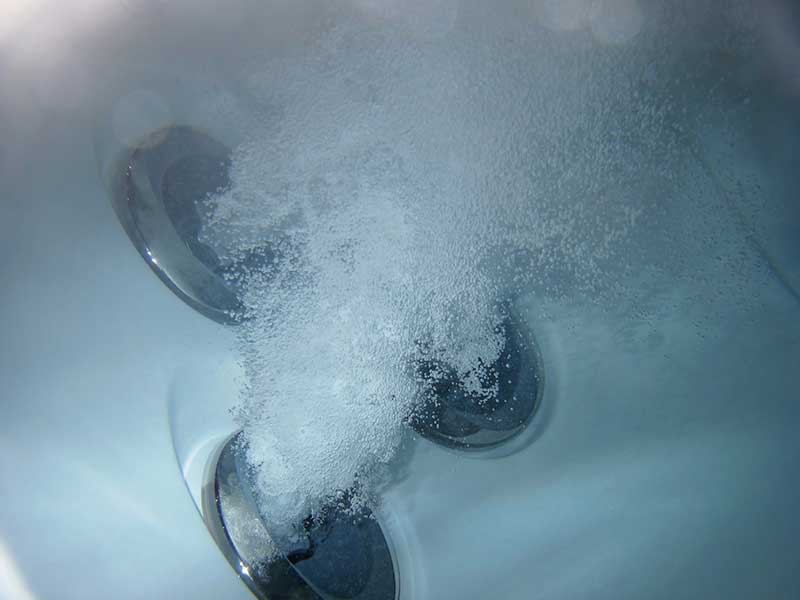
Other spa heaters have flow switches either instead of or as well as a pressure switch. A flow switch will not sense water pressure but will sense water flow instead. Whenever the water flow is sufficient, there are two paddles which are pushed together, closing off the circuit. If the flow is under the volume required, then the flow switch stays open so the heater doesn’t function.
It’s possible to test some types of flow switch by using jumper wires to connect both wires together to bypass the switch. Some flow switches may be able to be unscrewed from their housing to be inspected for corrosion or scale. While flow switches can’t be adjusted, they do need to have surfaces that are scale-free and their paddles need to remain unbent. In some cases, the paddles also have to be perpendicular to the flow of water for the heater to work properly.
Hot Tub High Limit Switch Problems
Another possibility is that the high limit switch is malfunctioning. This switch is similar to the thermostat and pressure switch as it forms a key element in the spa’s safety circuit. The purpose of the high limit switch is to prevent the spa heater from failing to shut down and, therefore, overheat to create boiling hot water or even cause a complete meltdown. The high limit switch is calibrated with a maximum temperature already preset at which the switch opens to break the electric circuit carrying power to the spa heater’s element.
Some tubs will have two high limits. One will be monitoring the temperature outside the heater and the other will monitor the temperature inside it. If there is a high limit switch error, there will often be an error code on the control panel. Typically, this will be an HL code or an OH code.
If your spa is older, it will have a red button that will pop out once the high limit is reached. If your spa routinely trips the high limit switch, this could be down to a lower water flow which is causing the heater temperature to get too high, or it could be down to a malfunctioning element, incorrect voltage, loose connections in the wires, damage to the wires or even a fault in the high limit switch.
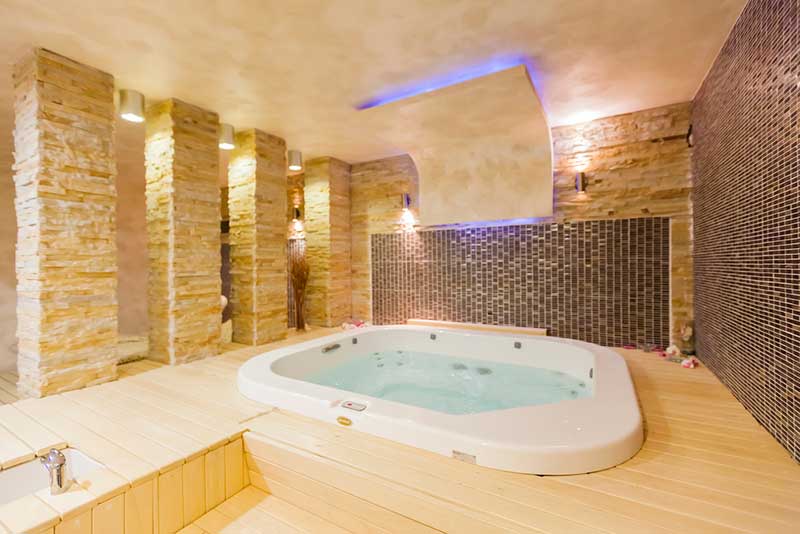
If you suspect a water flow problem or a problem with a malfunctioning switch lies at the heart of your failed water heater, you should consider calling in an electrician to identify the cause and to rectify the problem.
Is The Hot Tub Thermostat At Fault?
Your hot tub will have a thermostat that is turned up to make the water hotter. A lot of newer spas have a temperature sensor that is connected to the circuit board with a control panel on the top that acts as a remote control. Older spas have solid state probes and potentiometers, while even older ones have mechanical thermostats and capillary bulbs. All of these components are susceptible to failure.
In new spas with heaters that have a control panel on the top, there is usually a temperature sensor rather than a thermostat. This will plug into the spa controller’s main circuit board with a probe end that fits into the thermowell. You can inspect the probe and its cord for any possible damage and to check that it is snugly fitted into the panel.
If the control panel on the top is displaying the wrong water temperature, it’s possible that the temperature sensor is faulty. However, the problem could also be down to an issue with the control panel itself, particularly if you see any signs of water damage or if the panel isn’t responding to input.
Again, an electrician can help to identify the cause of the problem and rectify it rapidly.
Should I Replace My Hot Tub Heater Element?
A hot tub heater element is like an electric hot water heater element. If it is allowed to operate without sufficient cool water around it, it will cause the spa heater elements to burn out rapidly. It’s possible to test a hot tub element to work out whether a short has occurred in the coating that surrounds the heating element.
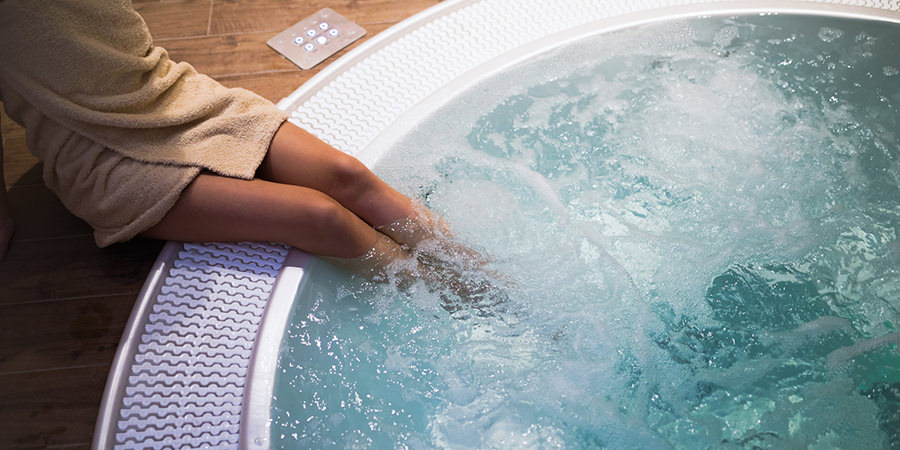
You can use a test meter that is set on ohms to measure the resistance of the spa heater element. If the element is functioning properly, it should typically display between 9 and 12 ohms. If the element goes to infinity or if the level continues to slowly rise the element has a short and therefore it should be replaced.
There is a large selection of heating elements on Amazon here.
It’s also possible for spa heater elements to develop a build up of scale either from hard water or from sanitizing the water with salt systems. If the spa element has developed scale on its outside, the heat output of the element is reduced and this, in the end, can cause the element to fail. A spa heater element looks a little like a stove top heater coil and, so, should the element’s outer casing get cracked you’ll need to replace the whole element.
In hard water areas, you’ll need to use a sequestering agent as this will keep the calcium scale in solution. The alkalinity should also be kept at around 70 to 80 ppm as this will also help to reduce the amount of scale that forms on the heater elements.
If you have a newer spa, you’ll probably find that the spa heater element has been housed inside a stainless steel chamber and it will have unions to allow for easier removal. If you have one of these complete spa heaters, you’ll be able to test the pressure switch, high limit and element for resistance in ohms.
When you test with an ammeter or multimeter, a short is when there is either little or no activity on the meter. An open reading is if the meter spikes and shows a very high reading. If there isn’t any resistance, the current is finding a way to leave the circuit and this is called a short circuit.
If you suspect that the hot tub heater element is broken or malfunctioning and may need to be replaced, you should contact an electrician with experience in dealing with spas so they can identify the source of the issue and rectify the problem quickly.
Are There Any Other Causes Of Spa Heater Problems?
Although all of the above options could be the cause of your spa heater problem, there are some other potential issues which could lie at the heart of your water failing to heat up. These problems with the spa heater are often caused by issues that you’d never think about, yet they’re often the simplest causes to solve, so you should check to see if any of them are resulting in your problem first so that they can be ruled out before you tackle any more complex investigations.

Some of the simpler potential problems to check out include:
- Has the GFCI tripped? You should look for your spa pack’s electrical outlet with a red test button. Check to see if the button has popped out and if it has, push it firmly back into place.
- Is the door interlock open? A lot of spas have a spa pack cover switch or cabinet switch cover that prevents operation unless the doors have been closed tightly. Make sure that yours is firmly shut to ensure proper operation.
- Does the spa cover need replacing? If the spa cover is ill-fitting, broken, torn, damaged or warped the heat in the water can rapidly escape and the water heater won’t be able to warm the water quickly enough to keep it at the right temperature. Check the cover thoroughly and, if you spot any issues, replace it with a new one.
- Are there loose wires? The connections in the wires need to be tight and shouldn’t be oxidised. Also, wires that have been chewed by rodents, melted by overheating or crimped due to pressure could be causing the problems you’re experiencing with heating your water.
- Has the fuse blown? A power surge or spike, or incorrect voltage levels could have damaged the fuse on the control board. You should check this out and, if necessary, replace the fuse with a new one. This could rectify the problem quickly and easily.
It’s always wise to check out these potential causes of your problem before you look for a more complex cause. These are all problems that you could possible resolve yourself without calling in a professional electrician’s help.
Related Questions
Can I make the hot tub hotter? It’s possible to make a hot tub warmer by following a few simple steps, but remember that all modern spas have been set so that they won’t go higher than 104 degrees Fahrenheit. You should never try to make your tub’s water hotter than that temperature.
First, set the temperature for your tub to the maximum level then turn on the water jets so that they’re circulating the water, allowing the entire tub to heat effectively with no cold spots. You should also line the interior of the hot tub with insulation boards and layer spray foam on the reverse of the tub, around the jets and pipes to ensure minimal heat loss.
Can I reset the hot tub’s heater? If you reset the hot tub’s heater, it may help to resolve any heating issues you’re experiencing, including a tub that takes too long to reach maximum temperature or a tub that doesn’t heat up at all.
You can achieve this by turning off the hot tub’s power at the breaker, finding the high limit reset button and pressing it. Next, turn the tub back on and check whether it’s heating correctly. Once you’ve followed these steps, you should find that the hot tub’s heater is reset and with any luck, you’ll be able to enjoy warm water in your tub once more. If it doesn’t resolve the issue, though, you’ll need to look at the possible causes above and call out professional help whenever necessary.

